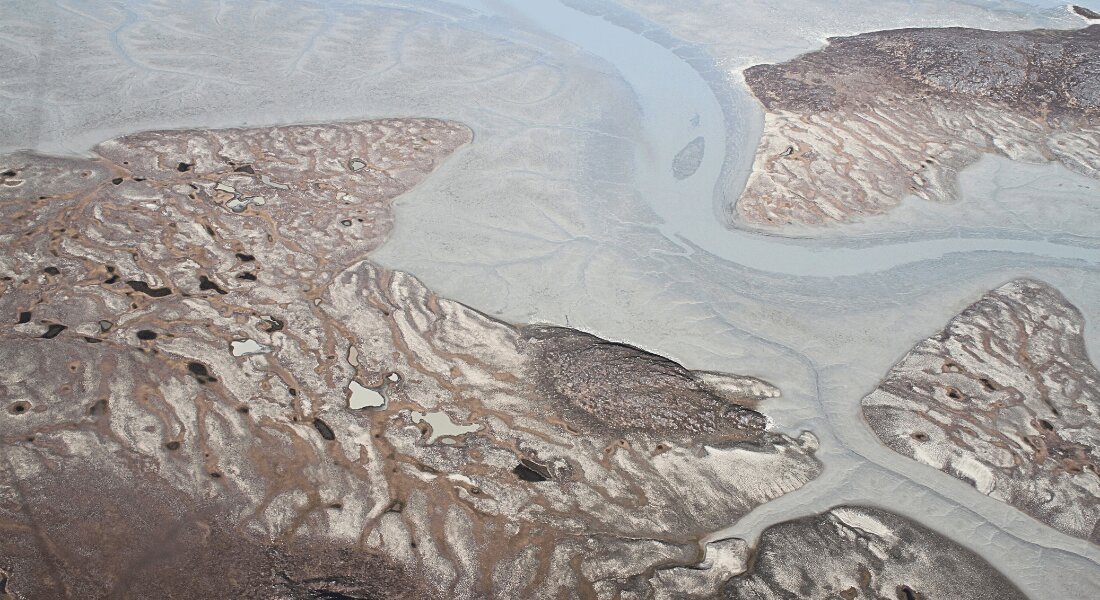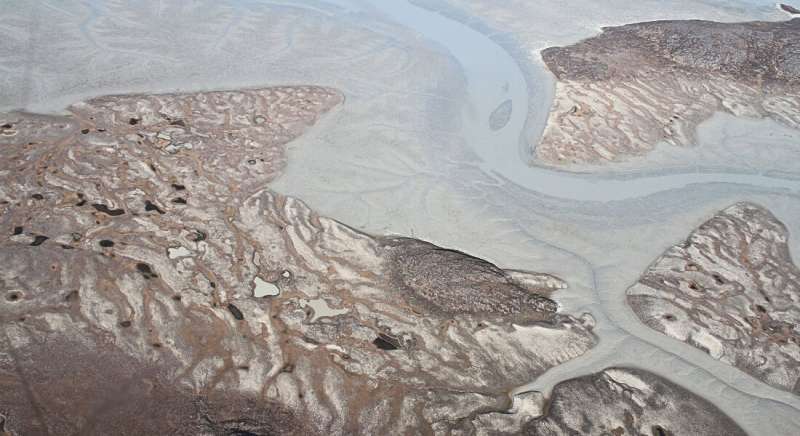

The first experiments with glacial rock flour from Greenland show that it can capture significant amounts of CO2 and provide a wider array of nutrients than commercial organic fertilizers, resulting in improved crop growth. In the long term, the glacial rock flour can be of great importance in stopping climate change. The researcher behind the studies calls it a “promising, scalable solution.”
A lot of gray mud. The Greenland Ice Sheet slowly crushes the landscape on which it rests into a very fine powder, which is called glacial rock flour.
It lies like gray mud in the otherwise lush green or snow-white Greenlandic landscape and at first glance, looks like nothing special.
However, two new studies show that glacial rock flour is something very special.
In the studies, the researchers have spread the fine powder on Danish fields in Southern Jutland.
The results establish that the glacial rock flour can be used to capture large amounts of CO2 through a carbon removal technique known as enhanced rock weathering.
At the same time, the glacial rock flour was able to improve crop yields even when a standard, organic fertilizer had no effect.
“Our studies indicate that glacial rock flour can be a significant part of the solution when it comes to reducing atmospheric CO2 levels,” explains researcher Christiana Dietzen, who is a soil scientist at the Globe Institute at the University of Copenhagen and one of the researchers behind the studies.
The researchers have calculated that you would be able to capture over 27 million tons of CO2, if you take the results of the study as a point of departure and imagine that you spread the same amount of glacial rock flour on all agricultural land in Denmark.
This amount is comparable to Denmark’s total annual CO2 emissions.
It is important to note that this is assuming similar environmental conditions, as in the study and the timescale of this uptake is still uncertain.
“It is a simple and scalable solution that could be used both in Denmark and globally. Unlike other sources of silicate minerals for enhanced weathering, glacial rock flour does not need any processing, and the amount available in Greenland is effectively unlimited,” Christiana Dietzen says, adding that it is not expected to negatively influence the Greenlandic environment, as the annual production of glacial rock flour greatly outpaces the amount that would be feasible to extract.
On the other hand, it could give Greenland an economic opportunity if the Greenlandic glacial rock flour becomes a valuable commodity.
However, Christiana Dietzen emphasizes that it is essential to keep track of how much CO2 is emitted by transporting the glacial rock flour from Greenland to other countries.
“It is important to account for the carbon footprint of transporting the material to make sure that the use of glacial rock flour is truly carbon negative and to avoid using it in locations where the transport emissions would outweigh CO2 uptake,” she says.
More potatoes and corn
In addition to the fact that glacial rock flour can capture CO2, the new experiments show that it also acts as fertilizer. Compared to an organic fertilizer, which provided additional potassium, magnesium, and sulfur, the glacial rock flour actually worked better, presumably because it provides a wider array of plant nutrients
“Surprisingly enough we saw no effect of the organic fertilizer, which indicates that the soil at our site was already nutrient-rich. However, we saw an increase in growth on the part of the fields where we had spread glacial rock flour. There, we saw a 24% increase in the harvested yields of maize and a 19% increase in potato tubers,” says Christiana Dietzen.
It was only the first year that the researchers could see that the glacial rock flour had an effect on crop growth in the fields in Southern Jutland.
“The soil conditions at this site were suitable for capturing CO2, and the glacial rock flour also provided a co-benefit of somewhat increased soil fertility. On the other hand, we have done some experiments in Ghana, where we saw a really impressive increase in crop yields of 35% on average that have persisted so far for four growing seasons,” she says. This increase in plant growth also has the potential to sequester additional CO2 as organic carbon in plants and soils.
The researchers are still working on the experiments in the Ghanaian fields, but so far, it has surprised Christiana Dietzen how big a difference it makes when fertilizing with glacial rock flour.
“The experimental fields in Ghana were very nutrient-poor, which is likely why we see so much more of a response than in the nutrient-rich field in Denmark, as crops in nutrient-poor environments will benefit much more from added nutrients,” she says and adds:
“In environments like Ghana, the fertilizer benefit alone may be enough reason to import glacial rock flour from Greenland.”
Not an immediate solution
The researchers can calculate the maximum potential CO2 uptake of the glacial rock flour in advance based on its chemical composition.
But when they finished the project after three years, they had not seen the full effect.
“We have only reached 8% of the glacial rock flour’s potential to transform CO2 in three years. The implication here is that though this process is effective, it is not a quick solution, but could take decades to realize its full potential,” stresses Christiana Dietzen. However, if it is implemented now enhanced weathering can contribute to achieving global goals of achieving net-zero by 2050.
“We have several three-year trials planned in Denmark, Ghana and Australia. Hopefully within this time frame the first commercial applications of glacial rock flour will also have begun on Danish agricultural fields so that the process of capturing CO2 can begin.”
How does glacial rock flour work?
The very small size of glacial rock flour particles is an advantage over other minerals that can be used for enhanced weathering, as energy-intensive crushing is often needed to break rocks down into a small enough particle size.
When the fine glacial rock flour is applied to Danish fields, it can capture CO2 by converting it into bicarbonate (HCO3–). This chemical compound can eventually ends up in the oceans, where it can remain for thousands of years, and can actually help make the oceans less acidic to the benefit of animals and plants.
The findings are published in the journal Nutrient Cycling in Agroecosystems and the International Journal of Greenhouse Gas Control.
More information:
Klara Cecilia Gunnarsen et al, Greenlandic glacial rock flour improves crop yield in organic agricultural production, Nutrient Cycling in Agroecosystems (2023). DOI: 10.1007/s10705-023-10274-0
Christiana Dietzen et al, Quantification of CO2 uptake by enhanced weathering of silicate minerals applied to acidic soils, International Journal of Greenhouse Gas Control (2023). DOI: 10.1016/j.ijggc.2023.103872
Provided by
University of Copenhagen
Citation:
Greenlandic glacial rock flour can help fight climate change, show two new studies (2023, May 31)
retrieved 31 May 2023
from https://phys.org/news/2023-05-greenlandic-glacial-flour-climate.html
This document is subject to copyright. Apart from any fair dealing for the purpose of private study or research, no
part may be reproduced without the written permission. The content is provided for information purposes only.